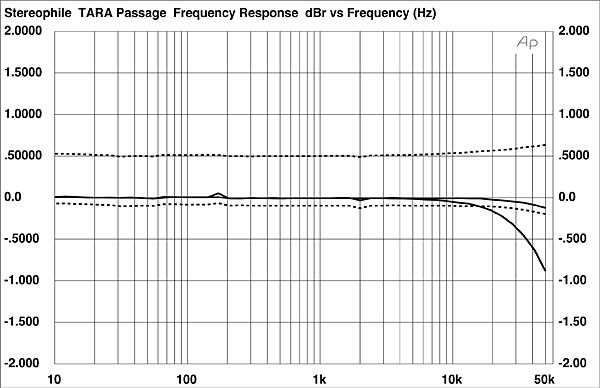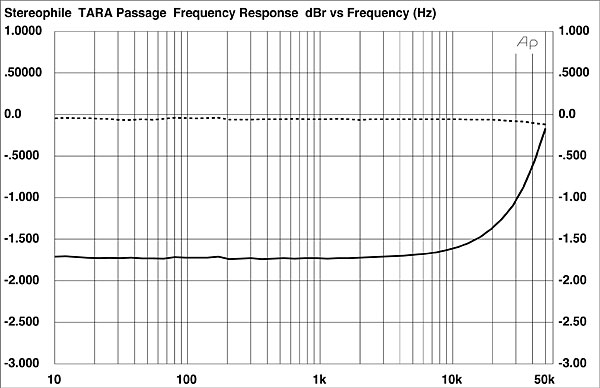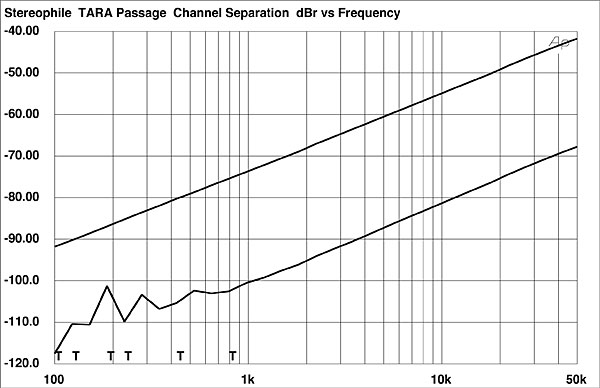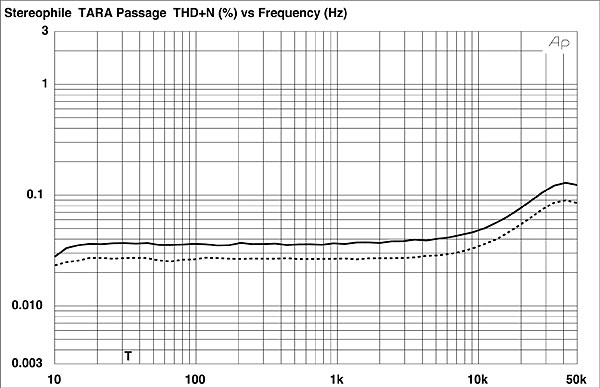| Columns Retired Columns & Blogs |
TARA Labs Space & Time Passage preamplifier Measurements
Sidebar 1: Measurements
The output impedance of the Passage preamplifier at its main outputs measured a highish 912 ohms at any volume control setting. The input impedance measured just over 27k ohms (left channel, slightly lower in the right) at full volume, increasing to just over 37k ohms in the 9 o'clock position of the volume control. The output impedance of the tape outputs measured about 47.4 ohms with either a 25 ohm or 600 ohm source, indicating that these outputs are buffered. Unity gain was at 2 o'clock on the volume control; the maximum gain of the preamp was 37.7dB. DC offset fluctuated between +0.2 to –0.3mV in the left channel, ±0.8mV in the right. The Passage inverted polarity at both the main and tape outputs.
Figs.1 and 2 show the unusual results from measurement of the Passage's frequency response. In fig.1, two measurement conditions are overlaid. The two middle curves (referenced at 20kHz) indicate the response at full gain with the balance control physically centered. Not much of note here—a practically flat response across the band, with a good level match between channels. But look at the bottom and top curves, taken at the unity gain setting: the channels are now mismatched by 0.45dB. More significantly, the right channel has gone from a slight droop at 50kHz to a slight rise, while the left channel is now down by almost 1dB at 20kHz. In fig.2, the level control is set at 20dB below unity gain (about 9:20 on the volume control). Here, the left channel has flattened out again, while the right channel is down in level by almost 2.5dB relative to the left—an almost 3dB drop from its position at unity gain relative to the right channel. Furthermore, the response at 20kHz for the right channel is up by over 1.5dB at 50kHz. (Note that the vertical scale has been shifted slightly for fig.2.)

Fig.1 TARA Space & Time Passage, frequency response at full gain (two middle curves at 20kHz) and at unity gain, load impedance 100k ohms in parallel with 110pF (right channel dashed; 0.5dB/vertical div.).

Fig.2 TARA Space & Time Passage, frequency response at 20dB below unity gain, load impedance 100k ohms in parallel with 110pF (right channel dashed; 0.5dB/vertical div.).
These high-frequency response deviations are not, for practical purposes, very significant; they are under 0.5dB below 20kHz, and are unlikely to be audible. But they are unusual. Even allowing for the fact that a 9:20 setting on the volume control is a very low level and unlikely to be used for critical listening, the volume-control tracking is rather marginal for this product's intended market. TARA needs to look into improving it.
While the crosstalk performance (fig.3) shows some asymmetry between channels, a fairly common occurrence, it would be more impressive if the left-to-right crosstalk were comparable to the crosstalk in the other direction. Still, the results, with separation better than 50dB in the audio band, are unlikely to have audible consequences.

Fig.3 TARA Space & Time Passage, channel separation at 1V input, level control maximum, L–R (top) and R–L (bottom) (10db/verical div.).
The manner in which THD+noise varies with frequency for a 100mV input signal and the volume control set to full is shown in fig.4. The rise at higher frequencies is not unusual, and the results are good for a unit incorporating tubes in its design. The Passage accepted an input of 4.3V before reaching clipping (1% THD+noise), producing an output of 24.7V in the process.—Thomas J. Norton

Fig.4 TARA Space & Time Passage, THD+N (%) vs frequency at 100mV input into 100k ohms, level control maximum (right channel dashed).
- Log in or register to post comments




































